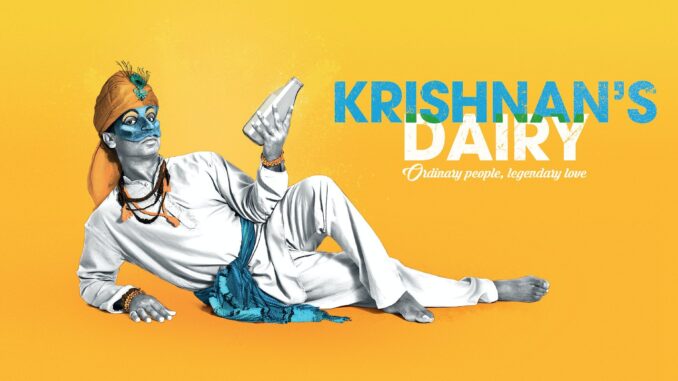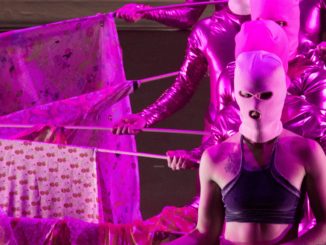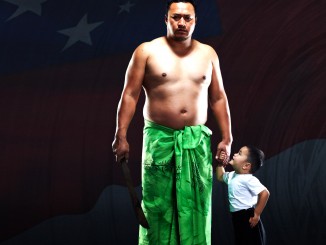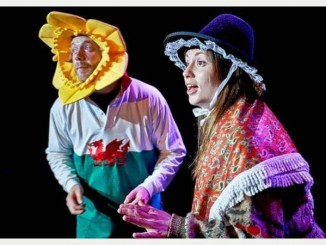
[Krishnan’s Heart]
Krishnan’s Dairy premiered in 1997 and was the Winner of the prestigious Edinburgh Fringe First Award, and two Production of the Year Awards in New Zealand.
Brightly coloured sheets of material hang from the ceiling, evoking the sari. Centre-stage, the Dairy counter is made from simple wood, patchworked with coloured new-stories and painted blue. Jacob and his musician Adam Ogle enter, strumming classical guitars with a jaunty riff, and Jacob’s Kiwi-accented, folk-lyrics lift through the auditorium.
Tonally, we shift into Jacob’s character-switching – this time with lightning-fast mask changes depicting Gobi and wife Zina as they go about their day. The couple are recent immigrants, trying to run a successful business in a strange land whilst undercut by supermarkets and disturbed by racism towards them. All the while, juggling the needs of their newborn son.
Jacob’s strengths lie in his ability to write and bring to life witty dialogue through an array of skills – even more impressive given that only part of his face is visible. The majority of the production is laugh-out-loud funny, depicting Gobi and Zina’s reparte.
Having seen and been enamoured with Indian Ink’s Paradise or the Impermanence of Ice Cream, I entered Q Theatre with pre-concieved notions of how this review will be swayed by that experience, and will therefore primarily consider Jacob’s growth as an artist. However, it would be a disservice to both productions to do just that.
Krishnan’s Dairy is incomparable because it is mass of contradictions: twee country music juxtaposed with a story of a Mughal Emperor; laughter juxtaposed with deep, heart-wrenching pain. None of this is a criticism. It is a testament to the range of insight within Jacob’s storytelling and why the production can stand-alone and can be complemented by, but does not rely on, the sequel offering of Mrs Krishnan’s Party.
At the core of Krishnan’s Dairy is a discussion about whether the story of Shah Jahan – the Mughal Emperor who created the Taj Mahal as a mausoleum for his late wife, Mumtaz – is an appropriate bedtime story for their baby to hear. It may seem to some like a throwaway moment, but references to nursery rhymes Jack and Jill and Humpty Dumpty stick with me.
Many stories with harrowing under-currents were, until only recently, reverred in Western cultures. It is interesting to consider how this has changed over the last 25 years, since Krishnan’s Dairy first premiered. Now, more than ever, parents are more conscious of the material they expose their kids to and there is no doubt that the stories we tell our children, about their culture and ours, shapes who they become.
As this is the matinee performance, it means there are at least two children in the audience nearby – one beside me who perpetually turns on his smart-watch to check the time, and a younger one in the centre of the row behind who, although having enjoyed and understood the comedic interplay and mask use, becomes unsettled during the dramatic denoument and repetitively asks his parent if it is time to go. Jacob, a stalwart professional, raises his voice over the chatter but the interruptions do detract from the narrative and his performance.
What colours my enjoyment of the production, far more than a restless child, is an older woman in the row in front of me who laughs during a similar dramatic denoument – this time involving a racist altercation. The sound feels like a slap. I wonder what it would take for someone to think the moment is anything other than heartbreaking; to realise the moment is not funny, is not a moment of ‘entertainment,’ as the previous half hour has been. Maybe it requires the same lived-experience, but the audience is predominantly Pākehā. It makes me feel protective over the character’s vulnerabilities, and Jacob’s too. I consider why – and for who – this art has been created, and what it means to open our hearts to people who might not always understand.
The narrative of Krishnan’s Dairy is earnest, seen through the classical guitar strumming and Kiwi accent of Jacob’s first character – which, on first experience, felt jarring. Yet, in the finale moment when his song is reprised it brings me to tears. It encapsulates, for me and I’m sure for many others, what it means to be a second generation immigrant: an accent ‘not matching’ your skin colour; cultural awareness rooted in what your parents chose to tell you, because they were hiding you from the racism of the only country you’ve ever called home.
Yes, the moment stung, but I’m at peace with watching Krishnan’s Dairy behind the older woman who laughed. She reminds me of other Kiwis of her generation, with whom I’ve tried to discuss the systemic racism in this country and found my words fall on deaf ears. Perhaps, upon reflection, watching the production will have been a view into a world she only ever saw in passing – a new level of sympathy and understanding created for people who don’t look like her.
I don’t resent the distracted young kids around me during this production, either. Theatre is something to be shared after all, and maybe one day they’ll think back on the time they watched a brown-skinned man command and captivate an audience for over an hour – a man who received rapturous applause, who humbly addressed the sea of faces after showing us a little piece of his heart. That said, I hope there comes a time when their parents explain exactly what, aside from the funny mask work, they truly saw. What it meant, and why it matters.
Krishnan’s Dairy tours Aotearoa through June and September 2022.
Mrs Krishnan’s Party (sequel) at Q Theatre from 16th June – 3rd July.
To celebrate 25 years of Indian Ink Krishnan’s Dairy and Mrs Krishnan’s Party will be performed together for the first time ever, from the 16th – 26th June at Q Theatre. Details see Indian Ink Theatre Company.




Leave a Reply